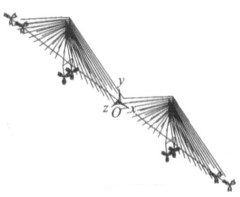Influence of traveling wave effect on seismic mitigation control for long-span cable-stayed bridge
Article Text (Baidu Translation)
-
摘要: 为了研究行波效应对斜拉桥减震控制地震反应的影响, 推导了多点地震动输入下的大跨桥梁减震控制计算方法, 以一座大跨飘浮体系斜拉桥为实例, 在桥塔和桥墩处设置阻尼器, 建立其三维有限元模型, 分析了行波输入下半主动控制和被动控制对斜拉桥的减震效果。计算结果表明: 半主动控制比较缓和地控制桥梁的地震反应, 而被动控制则急剧地控制桥梁的地震反应, 因此, 要慎用被动控制; 行波效应对无控制、半主动控制和被动控制斜拉桥的桥塔均具有很小的不利影响, 仅使桥塔内力增大约10%, 对主梁均具有显著不利影响, 使主梁内力增大近8倍; 行波效应对半主动控制和被动控制减震效果的不利影响很小, 没有出现明显的控制效果变差的现象。Abstract: In order to study the influence of traveling wave effect on the seismic response of vibration mitigation control for cable-stayed bridge, a calculation method of seismic mitigation control for long-span bridge was presented under multiple ground motion inputs, and the vibration-suppressed effeetivenesses of semi-active control and passive control for a long-span floating cable-stayed bridge with dampers set on towers and piers were calculated and analyzed by its 3D finite element model. Calculation result indicates that semi-active control method can gently control the seismic response of bridge, passive control method can sharply control the response, so passive control method should be used carefully. Traveling wave effect makes little bad influence on the tower of cable-stayed bridge for uncontrol, semi-active control and passive control with the maximal augment of 10~ for internal force, but it can make serious bad influence on the beam with maximal augment of about 8 times for internal force. The bad influences of traveling wave effect on the vibration-suppressed effectivenesses of semi-active control and passive control are little with no obvious bad control effectivenesses.
-
[1] 欧进萍. 结构振动控制———主动、半主动和智能控制[M]. 北京: 科学出版社, 2003. [2] 王志强, 胡世德, 范立础. 东海大桥粘滞阻尼器参数研究[J]. 中国公路学报, 2005, 18(3): 37-42. https://www.cnki.com.cn/Article/CJFDTOTAL-ZGGL200503009.htmWANG Zhi-qiang, HU Shi-de, FAN Li-chu. Research on viscous damper parameters of Donghai Bridge[J]. China Journal of Highway and Transport, 2005, 18(3): 37-42. (in Chinese) https://www.cnki.com.cn/Article/CJFDTOTAL-ZGGL200503009.htm [3] 李忠献, 黄健, 丁阳, 等. 不同地震激励下大跨度斜拉桥的地震反应分析[J]. 中国公路学报, 2005, 18(3): 48-53. https://www.cnki.com.cn/Article/CJFDTOTAL-ZGGL200503011.htmLI Zhong-xian, HUANG Jian, DING Yang, et al. Seismic responses of long-span cable-stayed bridges under different patterns of earthquake excitations[J]. China Journal of Highway and Transport, 2005, 18(3): 48-53. (in Chinese) https://www.cnki.com.cn/Article/CJFDTOTAL-ZGGL200503011.htm [4] 刘士林, 梁智涛, 候金龙, 等. 斜拉桥[M]. 北京: 人民交通出版社, 2002. [5] 王成博, 史志利, 李忠献. 大跨度斜拉桥地震反应MR阻尼器半主动控制[J]. 天津大学学报, 2005, 38(2): 95-101. https://www.cnki.com.cn/Article/CJFDTOTAL-TJDX200502000.htmWANG Cheng-bo, SHI Zhi-li, LI Zhong-xian. MR damper semi-active control of seismic responses of long-span cablestayed bridges[J]. Journal of Tianjin University, 2005, 38(2): 95-101. (in Chinese) https://www.cnki.com.cn/Article/CJFDTOTAL-TJDX200502000.htm [6] DAI Ze-bing, HUANG Jin-zhi, WANG Hong-xia. Semi-active control of a cable-stayed bridge under multiple-support excitations[J]. Journal of Zhejiang University SCIENCE, 2004, 5(3): 317-325. doi: 10.1631/jzus.2004.0317 [7] 亓兴军. 桥梁减震半主动控制研究[D]. 北京: 中国地震局地球物理研究所, 2006. [8] 亓兴军, 李小军. 大跨飘浮体系斜拉桥减震控制研究[J]. 振动与冲击, 2007, 26(3): 79-82. https://www.cnki.com.cn/Article/CJFDTOTAL-ZDCJ200703020.htmQI Xing-jun, LI Xiao-jun. Study on seismic response control for a long-span floating cable-stayed bridge[J]. Journal of Vibration and Shock, 2007, 26(3): 79-82. (in Chinese) https://www.cnki.com.cn/Article/CJFDTOTAL-ZDCJ200703020.htm [9] 亓兴军, 李小军, 李美玲. 设置粘滞阻尼器的大跨斜拉桥抗震分析[J]. 铁道建筑, 2007, 47(1): 1-3. https://www.cnki.com.cn/Article/CJFDTOTAL-TDJZ200701000.htmQI Xing-jun, LI Xiao-jun, LI Mei-ling. Earthquake resistant analysis of large-span cable-stayed bridge with viscousdamper[J]. Railway Engineering, 2007, 47(1): 1-3. (in Chinese) https://www.cnki.com.cn/Article/CJFDTOTAL-TDJZ200701000.htm [10] 叶爱君, 范立础. 附加阻尼器对超大跨度斜拉桥的减震效果[J]. 同济大学学报: 自然科学版, 2006, 34(7): 859-863. https://www.cnki.com.cn/Article/CJFDTOTAL-TJDZ200607001.htmYE Ai-jun, FAN Li-chu. Seismic response reduction of a super-long-span cable-stayed bridge by adding dampers[J]. Journal of Tongji University: Natural Science, 2006, 34(7): 859-863. (in Chinese) https://www.cnki.com.cn/Article/CJFDTOTAL-TJDZ200607001.htm -





 下载:
下载:















